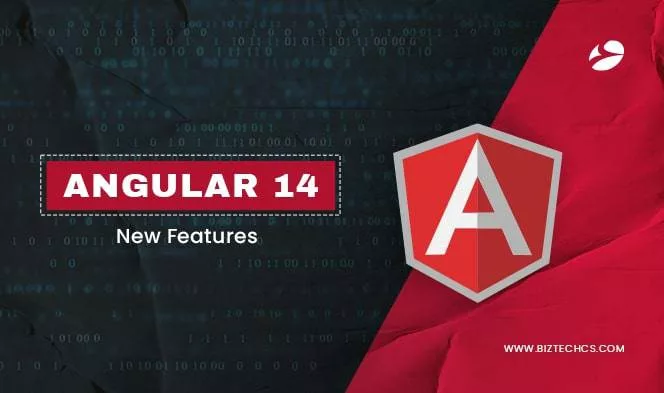4045
What’s New in Angular 14: Features, Updates, and More!
05 Jul, 2022
5 min read
4045
05 Jul, 2022
5 min read
Table Of Content

The latest Angular 14 version is here! And it addresses the many issues and concerns raised by developers in forums like Github. For instance, the introduction of strictly typed reactive forms is a result of that.
The Angular 14 upgrade, with its elaborate documentation, is now ready for use by developers. Its main focus is to ease the developer journey and boost the performance of applications.
Going forward in this blog, you will learn more about the new features, updates, and improvements made in Angular 14. And whether or not you should choose it for front-end development.
Stay with us!
After the huge success of the Angular 13 version released in November 2021, Google is now all set to take front-end development to another level with its latest Angular 14 version. The typescript-based web app framework was released on June 2, 2022, and is probably one of the most well-planned upgrades by Google.
The Angular 14 upgrade has now eliminated the need for ‘ngmodules’ as it supports standalone components, thereby reducing the time to build a boilerplate for Angular app development.
Besides this, the support for Typescript 4.7, typed reactive forms, directives, and CLI auto-compiled are a few new things you will see in Angular 14 that makes it a perfect choice for front-end development.
So, if you are planning for the Angular version update, here’s what you should expect from Angular 14.
These are some of the noteworthy Angular 14 features and updates you must know. Check it out!
If you are familiar with Angular development, you may have used the Angular CLI (command-line interface) to initialize and develop codes. And proficient developers can very well use the commands to develop modules, components, and directives for the application.
However, the plethora of commands at your disposal can make it difficult for you to develop applications. And developers often had to look up the internet and official documents for these commands.
But in Angular 14, the CLI is equipped to help the coder with its type-ahead and auto-completion features in real time. However, you would need to run the ‘ng completion’ command initially in the interface. You can type ‘ng’ and hit the ‘Tab’ button to see all the command alternatives. Hit ‘Enter’ to select the chosen one.
The Angular 14 can offer you more commands for your project, such as ‘ng generate’ or ‘ng create’.
Business benefits – Improved productivity, faster development, minimal error during programming.
Developer benefits – Fast-paced development, easier to write codes, minimized hassles of searching for commands.
Prior to the Angular 14 update, every component created in Angular had to be integrated within a module. Thus, it was mandatory for each component to have a parent module without which the application would throw errors and won’t work.
But with Angular v14, we have the option to utilize standalone components without having to integrate them within any module. However, this doesn’t imply that Angular has completely eliminated the modules as it is necessary to ensure they remain compatible with the present Angular system and its applications and libraries.
To declare Angular 14 standalone components, the standalone flag is utilized. And these components have no dependency on NgModules or intermediate NgModules and can be managed on their own.
Business benefits – Streamlined development, faster execution, improved performance.
Developer benefits – No need to use NgModules, can declare independent components and use simplified coding experience.
Read more: Vue vs Angular
One of the major concerns on GitHub about Angular was the execution of strictly typed forms. And Angular v14 has addressed this issue by accepting generic type reactive forms to improve the model-based architecture of Angular when working with forms.
The auto migration facility in the new version ensures that any prevailing Angular apps can be smoothly migrated without any interruption. In fact, the Angular team also monitors the complexity of APIs to assure smooth transitioning.
Another interesting thing for you to note is that Angular 14 doesn’t impact the template-based forms and developers can still use it.
Business benefits – Improved development architecture, and smooth migration of Angular apps.
Developer benefits – Glitch-free strictly typed reactive forms, availability of template-based forms.
Read More: What is new in Angular 17 Update?
At the time of development, developers practice adding a page title to indicate the unique contents of the page. In Angular v13.2, it was streamlined with Route.title in Angular router so that one can add page titles.
However, the need for any such imports is no longer necessary in the Angular 14 upgrade. This community contribution by developer Marko Stanimirović will help developers configure complex title logic by writing a customized ‘TitleStartegy’. Writing strongly typed page titles is now easier than ever!
Business benefits – Custom page titles to understand the page contents.
Developer benefits – Easier development, No need for imports.
One of the promising Angular 14 features is the all-new template diagnostics option. Similar to the way typescript code is protected, the Angular current version allows developers to compile and check minor errors and fix them efficiently.
Before Angular 14 was released, there was no provision for detecting minor errors like extra operators written in the code, incorrect two-way binding syntax, etc. And the system didn’t give any warnings unless any fatal error was observed.
Unlike before, the ‘Extended template diagnostic’ feature in Angular 14 enables the detection of minor errors and warnings. Thus, the option for private compilers, in this case, would help receive diagnosis reports or warnings and fix them for quality output, and better user templates can be created.
Business benefits – Quality code production, error-free app development, enhanced performance.
Developer benefits – Warnings for minor errors, easy diagnosis for minor to major to critical errors, detailed diagnosis report.
Angular DevTools version 1.0.6 was released on June 9, 2022. With profiling and debugging capacities, the Angular DevTool is an extension of Chrome DevTools. Developers can utilize the debugging plugin in offline mode.
Users with Firefox browsers can find this plugin under their Add-ons section and use it. The development tool can very well be used for assessing application structure, debugging, and profiling. In addition to the latest version of Angular, it is also compatible with Angular 12 or later versions.
Business benefits – Easy debugging, quick profiling, compatibility with Angular 12, or later.
Developer benefits – Quick debugging, a handy tool availability.
Creating embedding views in Angular 14 requires you to use optional injectors. You can use it via TemplateRef.createEmbeddedView and ViewContainerRef.createEmbeddedView. This process will allow developers to inject/add any dependencies into the object.
The Angular component development kit or CDK comes with an elaborate set of tools that assist in developing Angular components. And the Angular latest version features stabilized support for these primitives in CDK.
A few behavior primitives of the Angular CDK are :
Besides, the new primitives of Angular 14 allow the custom creation of components that can be accessed seamlessly.
Business benefits – Easier and custom creation of components, enhanced performance.
Developer benefits – Powerful tools to develop Angular components.
There have been plenty of in-built enhancements in Angular 14 that can improve the way you develop apps. Here’s a look at some of them :
Business benefits – Support to the latest technology, an enhanced platform for front-end development.
Developer benefits – More control to developers, the option to link to protected components, no devaluing of codes.
It is another exclusive feature of Angular 14. The ‘Extended developer diagnostics’ is an extendable framework that assists developers in better understanding the templates. It also provides suggestions so that developers can make the necessary changes and boost its performance for seamless and quality front-end development.
Business benefits – Improved templates for Angular 14.
Developer benefits – Easy to understand template designs, more options to boost template performance, exposure to unique suggestions.
While these are some of the major features available from the Angular 14 release date, there are plenty of other updates that are remarkably useful for developing seamless front-end experiences.
Here are a few such contributions from the Angular team and the contributors to the huge community.
I. Experimental ESM application builds.
Angular 14 enables developers to compile pure ESM output by introducing experimental ESM application builds for ‘ng build’. You can try this option in your application by updating the angular.json browser builder.
II. NgModel onPush.
One of the frequent issues observed in the previous versions of Angular was that any changes made in NgModel for OnPush components couldn’t reflect in UI. Thanks to community supporters, this issue is resolved now as the changes can easily reflect in UI in Angular 14.
III. Tree-shakeable error messages.
The tree-shakable error messages in Angular 14 can help developers detect and debug any errors in the written code. The newly released Angular version comes with runtime error codes. Thus, developers can click on the relevant references for the error and get detailed information on how to fix a particular error.
Here, you can build an optimizer that associates the error codes to the long-form strings of three-shaking error messages. Further, developers can visit the reference manuals provided by Angular to see efficient ways to fix the issue. It is one extremely useful feature of Angular 14.
IV. “Banana in a box” error.
At the time of two-way data binding, the code requires you to use‘[()]’. However, many developers end up writing the syntax wrong as ‘([])’. Since, the parentheses ‘()’ resemble a banana and ‘[]’ a box, the error caused is called the “Banana in a box” error.
Since the wrongfully written syntax is technically valid, it becomes a nuisance for developers to detect the errors. But in Angular v14, the team has offered guidance on how to fix the error in your CLI (Command-line interface).
Mentioned above are a few latest features and updates of Angular 14 for you to check. And if you decide to utilize the dynamic platform for creating frontend applications, you can hire angular developers and get started.
Furthermore, let’s give you a brief idea of how Angular 14 can be installed in your existing setup.
Supposing you have decided to install Angular 14 for use, here we will guide you with the procedure to install and update to Angular version 14.
NPM in Angular is like a package manager that consists of Angular framework, components, and CLI, via the NPM registry. You can install Angular version 14 via this NPM. All you have to do is write the command in CLI or the command-line interface.
npm install –global @angular/cli@next
This should help you install the latest version of Angular. In case you are looking for ways to update Angular to latest version, you can do it by executing the ng update.
For more information regarding the Angular 14 update, migration, and installation, you can hire Angular developers and seek the necessary assistance from them. However, choose a professional team to avail of Angular upgrade services and get the best-in-class solution.
Angular 14, with its many features, seems like a profitable option for businesses. The latest version focuses more on simplifying the developer experience by providing them with a smoother development platform.
The introduction of Angular 14 standalone components itself set an example that Angular is planning to create a smoother developer journey and more accessible and faster web experiences. Not only this, but they have also shared their willingness on partnering with other Google third-party teams to ensure developers can work seamlessly with Angular 14 (or any later versions to come) across products.
With its plans to simplify the developer journey and the way they work with the technology, this seems like the best time to update Angular to the latest version. You can not only leverage the multiple features that have been added to the platform, but you will also have a huge community to support your projects.
As evident, the community contributions in Angular 14 can further persuade you to consider the platform for fast and dynamic front-end development. Features like streamlined page title activity or detecting tree-shakeable error messages are some great contributions you can see in Angular 14.
Though new, Angular 14 comes with a lot of unique features and improvements that can elevate the developer journey, thereby improving the overall performance. So, if you are planning an upgrade to Angular 14 or start building your application using it, you will have all the assistance and improved experience.
For further assistance with your project, you can hire angular developers for the job from a reputed organization. And here at Biztech, we have a talented team of Angular developers who can assist you every step of the way for web app development.
The all-new Angular 14 version comes with many interesting features and improvements to aid in a smooth developer journey, quick detection of errors, and a performance boost. The latest version can help create dynamic front-end experiences that boost customer satisfaction, interaction, and engagement quotient. With all its new feature additions, it surely is a lucrative technology for developers and businesses to explore in 2022.
1. Which TypeScript version is supported with Angular 14?
Angular 14 supports the latest TypeScript 4.7 version for writing programs. And it doesn’t support anything older than Angular v4.6.0.
2. Which reactive form types support generic parameters in Angular 14?
FormArray, FormControl, AbstractControl, and FormGroup are some reactive form types that support generic parameters.
3. Are Angular 14 standalone components stable?
Standalone components in Angular version 14 are indeed a beneficial feature for developers to use. They are available in the latest version for development and exploration, but may not be as stable as you would like to think. The API is not quite stable because of the probable changes outside the backward compatibility model.
4. How to find the best company for Angular 14 development?
There are plenty of organizations that develop Angular applications and choosing the best amongst them can be a challenging task. To find the best one, write down your project requirements first and shortlist companies based on that. Once done, you need to assess the company portfolio and see if they have handled similar projects. Then, interview the developers from the team and decide accordingly.
Odoo
99
By Devik Gondaliya
02 Jul, 2025

Odoo
414
By Devik Gondaliya
25 Jun, 2025

Odoo
1035
By Devik Gondaliya
12 Jun, 2025